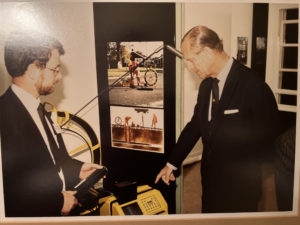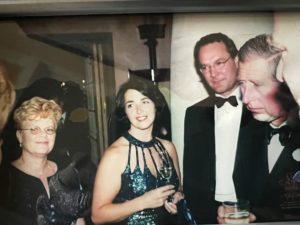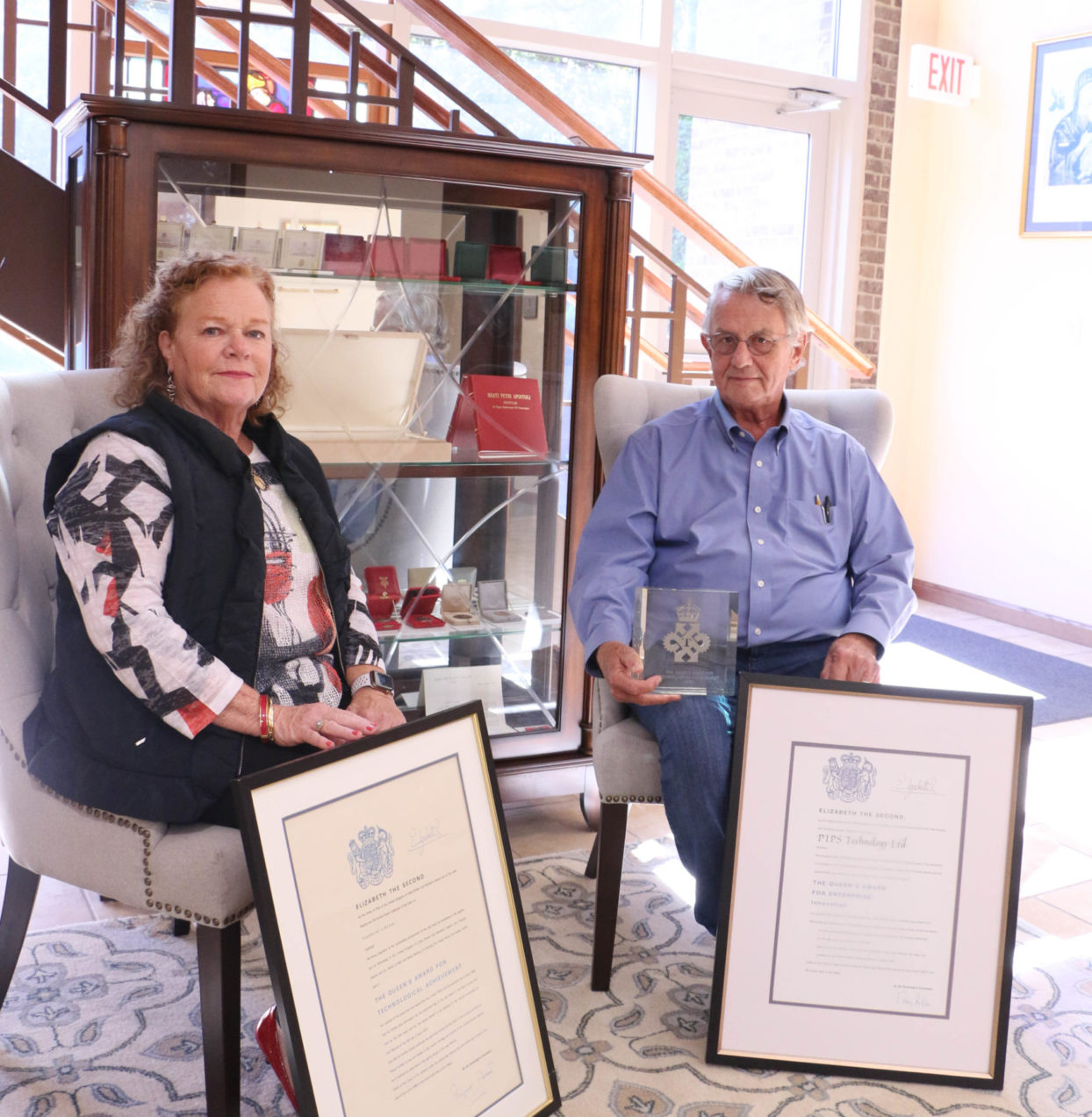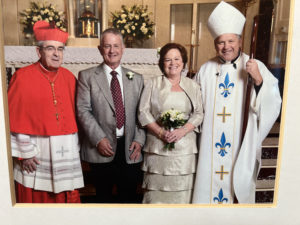By Bill Brewer
To many British, if not most, Queen Elizabeth II was no enigma despite the barriers that can separate royalty from the public.
She was omnipresent in their lives, whether through official royal functions, frequent public appearances, her annual Christmas addresses, or the constant stream of news coverage that shadowed her during her unprecedented 70-year reign.
She was ushered in as the 62nd monarch of England and Britain in 1952 at the age of 25 following the untimely death of her father, King George VI, who was 56. And now with her death, at the age of 96, her son assumes the throne as England and Britain’s 63rd ruler, King Charles III.
Great Britain natives Alan and Sally Sefton were just young children when Elizabeth became queen. They never envisioned their path crossing Buckingham Palace, but it did—on more than one occasion.
The Seftons relocated to the United States in 1990 because of Mr. Sefton’s business interests. They lived in Palm Springs, Calif., for 10 years before moving to East Tennessee.
They received their U.S. citizenship in Los Angeles in 2000 and in 2012 joined the Catholic Church in the Diocese of Knoxville, where they were originally members of St. John Neumann Parish in Farragut. They currently attend the Cathedral of the Most Sacred Heart of Jesus. Growing up in England, they attended the Anglican Church.
The Seftons, who are active in the Church in East Tennessee and serve as Knight Commander and Dame Commander in the Order of St. Gregory the Great as well as Knight and Dame in the Equestrian Order of the Holy Sepulchre of Jerusalem, have eight children: three who live in Great Britain and five who live in the United States. Their two youngest children attended St. John Neumann School as have two grandchildren..
Like much of the world, especially the United Kingdom, the Seftons are saddened by Queen Elizabeth’s death. She is the only British monarch they’ve known, although Mr. Sefton remembers from his childhood King George.
The Seftons also appreciate her reign and how she guided the monarchy through public and private tribulation.
They agree Queen Elizabeth II’s death is a major loss.
“She will be missed a lot. I think she’s done an amazing job,” Mr. Sefton said.
The Seftons thought it remarkable that the queen received prime minister Boris Johnson’s resignation and the next day (Sept. 6) she received Liz Truss as the new prime minister, and then two days later she died.
“She dedicated her life to serving the United Kingdom and the Commonwealth,” Mr. Sefton noted.
“She said she was going to, didn’t she? And he (King Charles III) said he’ll now do that,” Mrs. Sefton added.
The Seftons were taken with how Queen Elizabeth was thrust into public service at such an early age amid untimely grief. Mr. Sefton remarked how the queen has been the only woman from the British royal family to serve in the territorial armed forces. And until her death on Sept. 8, she was the only modern head of state to have served in World War II.
Mr. Sefton pointed out that Queen Elizabeth, as a young woman in England, was in uniform during World War II driving an ambulance among her duties. She also served as a mechanic. Her military service was the result of her decision when she turned 18 in 1944 to join the Auxiliary Territorial Service branch of the British Army.
“I think she was quite a humble person really, and she didn’t consider herself better than anyone else. You’ve seen her fix the Land Rover (British SUV) and driving it around,” Mrs. Sefton said.
Mr. Sefton spent a decade working for a company that developed radiation-tolerant cameras. He became a leader of that company, Rees Instruments, and was in charge of developing the business and its products.
And while he never knew at that time that he and his wife would relocate to East Tennessee, his work with Rees took him to the Los Alamos and Oak Ridge national laboratories.
“Development of that company went really well. In fact, the product I was involved in developing won a design award and to this day still is in production,” Mr. Sefton said.
The product is a camera used to see the core of nuclear reactors. Mr. Sefton left Rees in February 1983 and formed Pearpoint Limited in the United Kingdom.

Alan Sefton, earlier in his career, explains to Prince Philip, right, equipment his company produced that was recognized at the highest ranks in Great Britain.
Mr. Sefton’s business accomplishments led him to Buckingham Palace, where twice he received recognition and congratulations personally from Queen Elizabeth.
In April 1990, he received on behalf of Pearpoint Limited the Queen’s Award for Technological Achievement. Pearpoint had a patent for a flexiprobe rod critical to push camera technology used to inspect pipes. Pearpoint’s patents would result in additional business innovation.
A company spun off from Pearpoint Limited in 2001 was called Pearpoint Image Processing Systems (PIPS). It further developed technology used to read license plates, which has been widely used.
In April 2005, Mr. Sefton on behalf of PIPS received the Queen’s Award for Enterprise for the license-plate recognition technology. Again, Mr. Sefton received the award and congratulations from Queen Elizabeth. “I shook her gloved hand,” he recalled.
The Seftons’ brush with the royals didn’t end there.
During his entrepreneurial tenure, Mr. Sefton presented a product he was developing to Queen Elizabeth’s husband, Prince Philip. And he also mentions in light-hearted passing running into Lord Snowdon, Antony Armstrong-Jones, who was Princess Margaret’s ex-husband and Queen Elizabeth’s brother-in-law, in the bathroom during an event.
Mrs. Sefton still laughs at a chance encounter she had with Queen Elizabeth several years ago when the family lived in Palm Springs. The Seftons wanted to take their daughters to England to visit their grandmother and introduce the children to the family’s heritage.
“These girls were young and born in the U.S., but they were English. And we had never taken them to England. So, we go to England. Alan decided that on one of the days we should see London. So, we took my mom, who was so excited. She said to the girls, ‘We’re going to go to London to see the queen.’ I thought (incredulously), ‘Oh, yeah; OK, mom.’ We get on the train to Westminster Abbey, but you couldn’t get in because there was something going on there. We stood outside with a lot of other people. My mother took the girls’ hands and took them right up to the railing. And who should come out? The queen. She had just said to the girls, ‘We’re going to London to see the queen.’ And there we were, seeing the queen. It was so funny,” Mrs. Sefton recalled.

Sally Sefton, left, attends an event in Great Britain that was also attended by Prince Charles, right.
The Sefton’s encounters with the House of Windsor continued.
Charles, who now becomes England’s and Britain’s 63rd ruler at age 73, has been a presence in the Seftons’ lives on several occasions. As the Prince of Wales, he got to know the Seftons.
Mr. Sefton and then-Prince Charles met when the Prince of Wales officially opened a factory in Bristol, England, owned by an associate of Pearpoint Limited.
And then there was the dinner.
“We also met Prince Charles, now King Charles III, when we went to dinner at Highgrove House with him and Camilla. They weren’t married at that time. We were invited to go to a fundraiser there, where Charles lived with the boys. Diana had died,” Mrs. Sefton related.
She remembered that protocol dictated what they could bring to the dinner, very little it turns out, and cameras were prohibited. They also had to clear a security screening.
Mr. Sefton still laughs as he recalls that when they were first introduced to Charles at the dinner, the king-to-be looked at his wife, shook his finger at Mrs. Sefton, and said, “Don’t I know you?”
“We had stood around in the courtyard waiting with champagne for him to arrive, and I said, ‘Do we have to curtsy?’ So, we all talked about this and concluded, ‘Well, yes, perhaps we should. He’s Prince Charles. We should curtsy.’ But, of course, the curtsy went out the window once he thought he knew me. There was definitely no curtsying going on. It was a good experience,” Mrs. Sefton said with a wry smile.
The Seftons recollected that aides to the royals sent them notice to bring their “gardening shoes.” The couple wondered what for. As it turns out, Charles planned to give tours of the garden at Highgrove House.
With that dinner indelibly etched in their memory, they bought a signed, limited-edition painting of Highgrove House that was done by now King Charles III. It hangs in their bathroom at home.
As the couple laughed, Mr. Sefton said, “We’ve had a few experiences.”
The Seftons are impressed that Queen Elizabeth held it all together through Charles’ divorce from Princess Diana, Diana’s death, and the issues surrounding Prince Andrew, including his divorce from Sarah Ferguson, the Duchess of York.
“If there was ever a time when she (Queen Elizabeth) may have made a mistake, it was at that point (Diana’s death), in my view. The monarchy went right down because Diana was so popular,” Mr. Sefton observed.
“Everyone loved Diana so much,” Mrs. Sefton added.
Divorce was a recurring theme in Elizabeth’s lifetime, beginning when her uncle, King Edward VIII, abdicated the throne in 1936 to marry American socialite Wallis Simpson, who already was divorced from two husbands. That controversy opened the door for Elizabeth’s eventual reign.
The Seftons referred to the irony of Queen Elizabeth’s unlikely ascension to the throne because her father unexpectedly became king when his brother left the throne in December 1936, less than a year into his reign.
“I’m one of the few people who can remember the king and him dying (King George VI served as the monarch of the United Kingdom and the dominions of the British Commonwealth from Dec. 11, 1936, until his death on Feb. 6, 1952). It was a memorable time. We weren’t rich. My father had a normal job, and my mother worked as well. We had no TV, and we didn’t have a car. My dad went to work on his bike. But because there was going to be a coronation (of Queen Elizabeth II), my parents wanted a TV. So, my father bought this second-hand nine-inch television. The second time we used it it went up in flames, and they had to take it back. They then bought a new large-screen 12-inch black-and-white TV to watch the coronation. We had one channel, which was the BBC. I was 6. We had a street party,” Mr. Sefton remembered.
The Seftons pointed to Princess Margaret, who in the 1950s wanted to marry Capt. Peter Townsend, who had been divorced. Because of societal pressure and Margaret’s public office, their relationship ended before they ever married.
“Look now how the royalty has changed,” Mr. Sefton observed.
Mrs. Sefton noted Princess Anne, daughter to Queen Elizabeth and Prince Philip and King Charles III’s only sister, who was divorced from Capt. Mark Phillips in 1992 after 19 years of marriage. Princess Anne remarried in 1992.
“The only one who hasn’t divorced is Edward,” Mrs. Sefton said.
Controversy and intrigue continued to follow the royal family until Queen Elizabeth’s death, highlighted recently by son Andrew’s exploits and questions swirling around grandson Prince Harry and his wife, Meghan Markle.
“She held it together so well. The question now is whether he (King Charles III) can do the same. He seems to have started off well. They have these traditions. Reading back and knowing what happened at the time, he wanted to marry Camilla before she was Mrs. Parker Bowles. For some reason or another that was not to be, and he ended up with Diana,” Mr. Sefton said.
“She was never expected to become queen. I really think she did a great job considering she was never expected to be queen,” he added.
He said having his professional accomplishments recognized by Queen Elizabeth II has been a highlight of his career.
“Coming from where I came to build what we had and do what we did . . . we developed a really, really great team. All of these achievements were due to the team. I looked over my own role over the years as being the conductor of an orchestra. We have some wonderful musicians, but they don’t make the right noise without the conductor. Bringing it all together like that in both companies, we were very successful,” Mr. Sefton said.
He credited the queen for recognizing business development and research breakthroughs in the United Kingdom through the years.
He also emphasized how the queen will be missed by many in and outside of the United Kingdom, and how much she is missed will depend on how King Charles III fares in his new role.
“From what I’ve seen so far on the news, he’s done a reasonably good job,” he said. “He already has made an announcement that he is giving all the profits from the Prince Charles Trust he established, which sells products from organizations he supports, to the state.”
“He’s had a long time to prepare for this,” Mrs. Sefton said. “Come Christmas, when she always did her Christmas speech, that’s going to be interesting to see how he does that.”
As the Seftons—and the world—turn their attention to King Charles III, they’re hopeful he will serve as effectively as his mother did.
“The queen has really been part of our life all the way through. I think she’s done a really good job. There’s been a lot of anti-monarchy sentiment. We live in a republic now, but because they know we’re English, every person we know asks us what we thought of the queen and say they respected her. It’s lovely to see. All the flags here are at half-staff. It’s a great sign of respect,” Mr. Sefton said.


